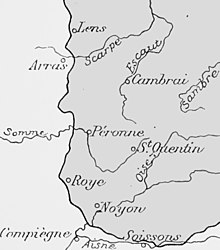Battle of Albert (1914)
The Germans had intended to outflank the French and drive westwards to the English Channel, seizing the industrial and agricultural regions of northern France and isolating Belgium.
On 18 August, General Albert d'Amade formed a defence line from Maubeuge to Dunkirk, to prevent the disruption of railways by German cavalry raids.
During 26 August, the division slowly retreated west of Cambrai; Groupe Ebener arrived at Marquion and were then ordered by Joffre to Combles and Péronne, to become part of the Sixth Army.
[3] Early on 28 August, the two reserve divisions advanced from Bapaume, taking the German II Cavalry Corps by surprise in its billets around Péronne.
[4] Further to the east, the French II Cavalry Corps, on the left of the BEF, failed to prevent the Germans from reaching the outskirts of Péronne on the evening of 27 August.
[5] On 11 September, the German garrison withdrew from Amiens and next day the Territorial divisions arrived from Rouen and captured a few stragglers.
The open western flank beyond the 1st Army and the danger of attacks from the National redoubt of Belgium, where the Siege of Antwerp had begun on 20 August, created a dilemma.
[9] On 21 September, Falkenhayn met Bülow and agreed that the 6th Army should concentrate close to Amiens, attack towards the Channel coast and then envelop the French south of the Somme, in a Schlachtentscheidung (decisive battle).
On 24 September, the Second Army was attacked and found difficulty in holding ground, rather than advancing round the German flank as intended.
[12] General Ferdinand Foch ordered the left flank of the French armies to move northward to Arras, Lens and Lille, to recreate a threat to the German northern flank, by moving through Arras to Cambrai and Le Cateau and from Lens to Valenciennes and Maubeuge.
If the French occupied the area between Cambrai, Valenciennes, Maubeuge and Le Cateau, the German forces on the upper Somme, Oise and the Aisne would lose the use of the two main railways to Liege, although this would not be decisive, since the line from Laon to Vervins, Hirson, Charleroi, Namur and Liege and that from Laon to Mézières and Montmédy to either Luxemburg and Treves or Thionville and Metz, would still be available to the Germans.
French moves to the north were also influenced by events in the siege of Antwerp, where Termonde fell on 26 September and increased the danger that the city and the Belgian army would be lost.
[18] On 25 September the German reinforcements attacked, crossed the Somme south of Péronne and then advanced to take a bridge between Hem and Feuillères.
The 4th Bavarian Division, further to the north, defeated the French Territorials and then attacked westwards towards Albert, through Sailly, Combles, Guillemont and Montauban.
The II Bavarian and XIV Reserve corps pushed back a French Territorial division from the area around Bapaume and advanced towards Bray-sur-Somme and Albert, as part of the offensive down the Somme valley to reach the sea.
[20] The XIV Reserve Corps attacked on 28 September, along the Roman road from Bapaume to Albert and Amiens, intending to reach the Ancre and then continue westwards along the Somme valley.
On 29 September, the 28th Reserve Division attacked Fricourt and captured the village but was prevented by French small-arms and artillery-fire, from advancing beyond.
[22] A lull in the fighting occurred overnight and then both sides began to dig in haphazardly, where the opposing lines had stopped moving, which was not always on easily defended ground.
[24][25] The French had been able to use the undamaged railways behind their front to move troops more quickly than the Germans, who had to take long detours, wait for repairs to damaged tracks and replace rolling stock.
[17] The French had been able to move troops in up to 200 trains per day and use hundreds of motor-vehicles, co-ordinated by two staff officers, Commandant Gérard and Captain Doumenc.
The French resorted to more cautious infantry tactics, using cover to reduce casualties and a centralised system of control as the German army commanders followed contradictory plans.
[28] By 4 October, German troops had also reached Givenchy-en-Gohelle and on the right flank of the French to the south, several Territorial divisions were separated from X Corps.
[33] The operation by the cavalry under Marwitz to the north of the 6th Army, had pushed back the French Territorial divisions to a line between Lens and Lille and on 5 October, Marwitz issued orders for the cavalry to advance westwards to Abbeville on the Channel coast and cut the railways leading south.
To the north, the I and II Cavalry corps attacked between Lens and Lille, were quickly repulsed and forced back behind the Lorette Spur.






